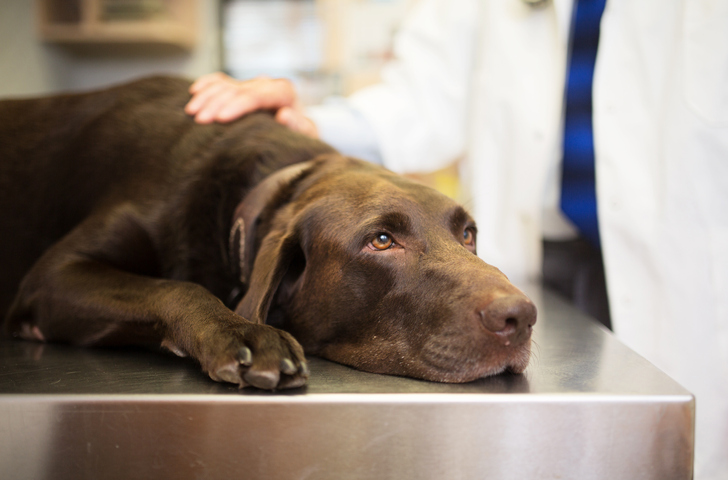What to Do if Your Dog is Having Seizures?
Being a responsible pet owner, it can be terrifying to witness your beloved dog suffer a seizure. A seizure is an instantaneous, uncontrollable electrical disturbance in the brain that can cause your canine to become agitated, shake violently, and lose control of its body. Dogs can experience seizures for a number of causes, such as hereditary predispositions, brain tumors, metabolic diseases, infections or poisoning. Knowing what to do in the event that your dog has a seizure is essential for keeping them secure and comfortable.
This article will outline the necessary steps to take if your dog has a seizure.

Phases of Seizures
Listed below are the phases:
1. Pre-ictal
This is a period of altered behavior during which a dog may hide or become nervous.
2. Ictal phase
This is the active phase of the seizure. It can look different for different pets. There will often be tremors and shaking as well as a loss of responsiveness and inability to stand. It could be mild or more severe and can be localized to only part of the body sometimes. In some cases, it is simply mild alterations in mental consciousness being confused, mild shaking, and lip-licking.
3. Post-ictal Phase
Immediately after the seizures end, the dog displays confusion, perplexity, salivation, and uneasiness. This can last anywhere from several minutes to even hours.
Steps to Take if Your Dog is Having a Seizure
Listed below are the steps to take as a pet owner when this happens:
Step 1: Remain Calm and Keep Your Dog Safe
When your dog has a seizure, the first thing to do is to stay calm. Dogs are emotionally perceptive and can tell when their owners are scared or nervous. So, it’s essential to maintain composure to stop your dog from becoming agitated. Additionally, you must keep you and your dog safe during the seizure. Clear any potentially harmful items from the area and take precautions to keep them from falling off furnishings or stairs. A soft pillow or comforter placed under their head can help shield them from harm while they are having a seizure.
Step 2: Time the Ictal phase of the Seizure
It is essential to time the seizure to know how long it lasts. Use a stopwatch to record the beginning and ending times of the seizure or ask a companion to record it on video so the veterinarian can view it. Most seizures last between a few seconds and a few minutes. If it lasts less than two minutes, there is no need for immediate veterinary however scheduling an appointment is warranted. If it lasts longer than five minutes, however, it indicates a medical
emergency, and you should seek veterinary assistance right away.
Step 3: Observe and Document the Seizure
Observing and documenting the seizure is important for your veterinarian to diagnose the cause of the seizure. Note the beginning and ending times of the seizure, its length, the bodily parts affected (such as twitching legs, drooling, or losing consciousness), and any unusual behavior that occurred before or after the seizure.
Step 4: Do Not Restrict Your Dog
Restriction during a seizure should be avoided as it may worsen the situation. Avoid attempting to hold their tongue or open their mouth because doing so could hurt both you and the dog. The seizure might become more intense if you shake or startle your dog in an effort to stop it.
Step 5: Provide Comfort After the Seizure
When your canine regains consciousness after the seizure, comfort him by speaking in a soothing, calm tone. Make sure to keep them warm and comfortable. Dogs may be disoriented and confused after a seizure, so give them space and avoid overwhelming them with attention. Dogs are more adept than people at identifying emotions and feelings. As a result, if you feel uneasy, your dog will too.
Step 6: Lowering your Dog’s Body Temperature
Seizures that last for more than 2-3 minutes have a direct effect on a dog’s body temperature that can lead your dog to risk of
hyperthermia. If it is safe to do so, take your dog’s rectal temperature and if it is 104 degrees or above, try to lower the temperature by applying cold water or wet towels over his groin, neck, and paws. If the seizure does not cease after a several minutes, it is called status epilepticus. Due to repeated muscular contractions, the dog’s body temperature will increase which can cause damage if the body temp gets too high.
Step 7: Contact Your Veterinarian
It is essential to speak with your veterinarian right away if your dog has seizures or if a seizure lasts longer than five minutes. To identify the underlying cause of the seizures, your veterinarian can conduct a physical examination and diagnostic tests. Depending on the underlying reason for the seizures, the recommended course of treatment may involve medication, dietary adjustments, or
surgery.
Step 8: Prevent Seizures in the Future
Preventing seizures in the future involves managing the underlying cause of the seizures. For instance, if your dog has a metabolic disorder, it may require dietary changes to manage its condition. Surgery may be required to remove the brain tumor if it is the source of the seizures. Most of the time, with an epilepsy diagnosis, seizures can be controlled with the help of medications, but these must be prescribed by a veterinarian. It is also important to note that some dogs may experience seizures despite all preventative measures. Working closely with a veterinarian in these situations is crucial to controlling the seizures and ensuring your dog’s safety and well-being. Dogs who have seizures can live happy lives if given the right care and attention.
Diagnosis of seizures
The veterinarians begin the diagnosis by gathering all of the patient’s medical information and focusing on any possible poison exposures or past trauma. In addition to a
physical check, the veterinarian will also draw blood and urine samples.
How Are Seizures Treated?
Typically, treatment starts after the canine has repeated convulsions across a few months or are immediately followed by another. Normally, a
veterinarian won’t advise anti-convulsant medication right after a single short seizure, but if the dogs experience seizures more frequently, a medication will be started to control them.
Seek Veterinary Care if Your Dog is Having a Seizure
Witnessing your dog have a seizure can be a frightening experience. However, being aware of what to do in case of a seizure can help to keep your canine secure and comfortable throughout the episode. It’s important to maintain calmness, protect your dog, and watch and record the seizure. During the seizure, don’t place any restrictions on your dog, and afterward, provide comfort.
If the seizure lasts longer than five minutes or if the dog has several seizures, you must consult your vet. To stop seizures from occurring again, you must address the underlying cause of the seizures and collaborate closely with your vet to develop a treatment strategy tailored to your dog’s requirements. You can contribute to ensuring your dog’s continued health and happiness by taking these essential steps.
For more information, contact The Chimacum Valley Veterinary Hospital in Port Hadlock, WA by calling 360-385-4488.





